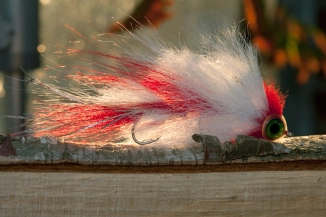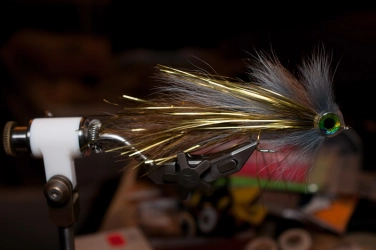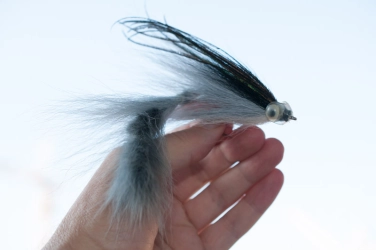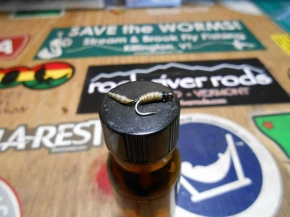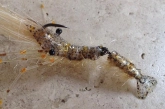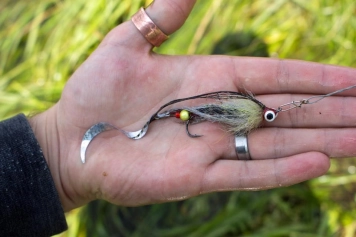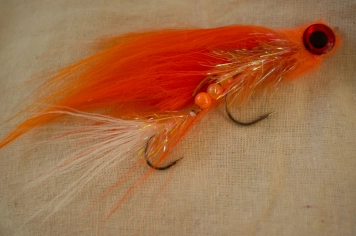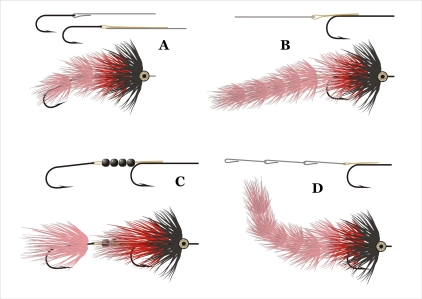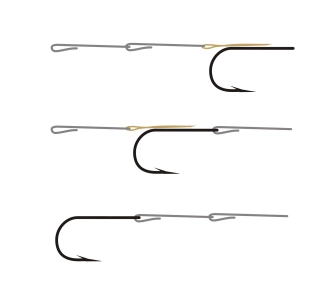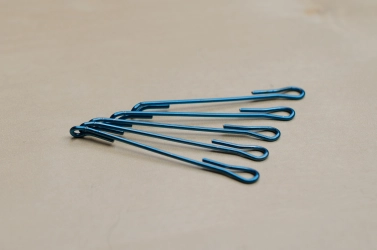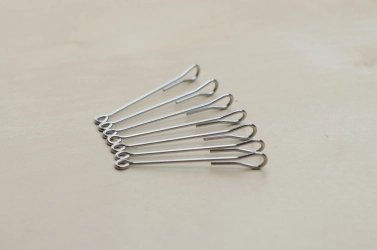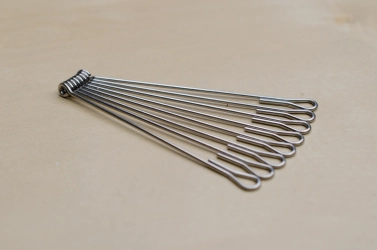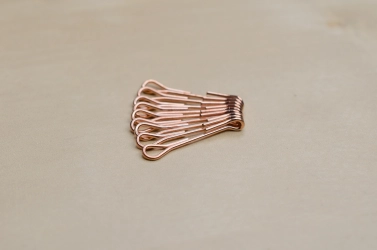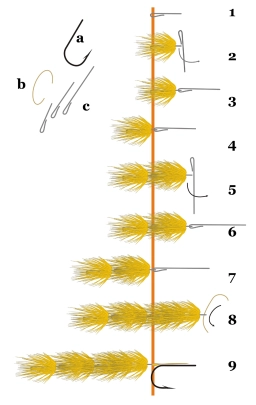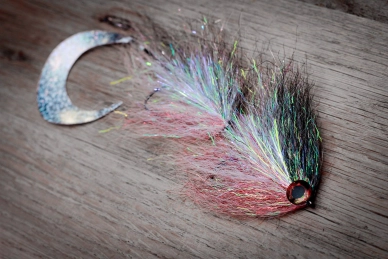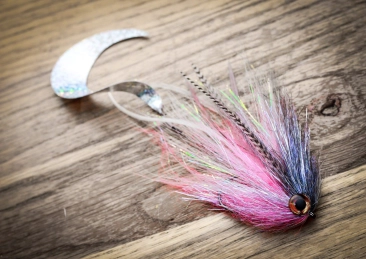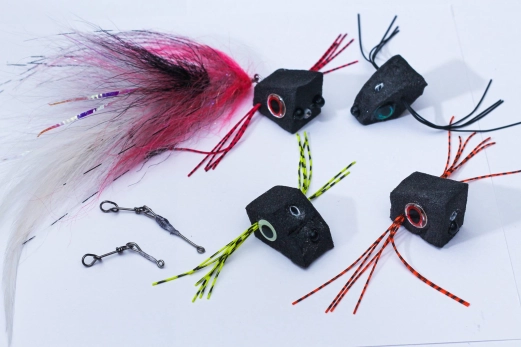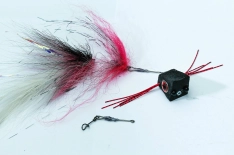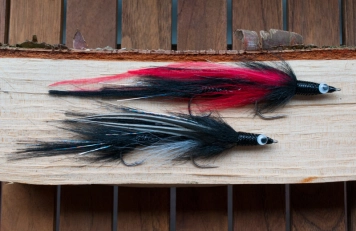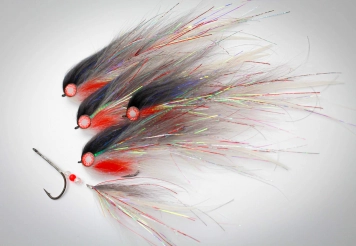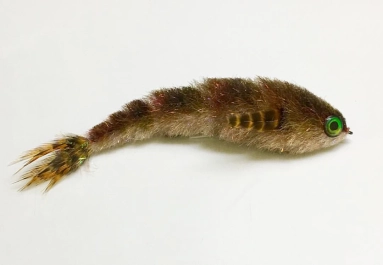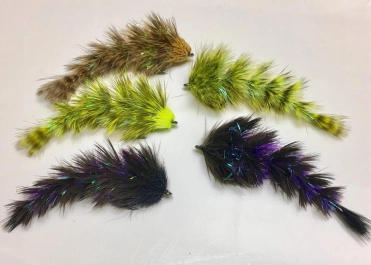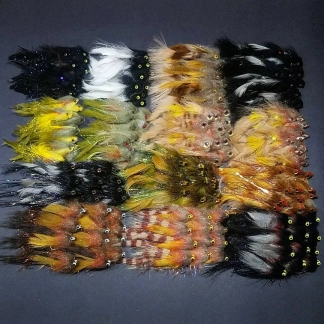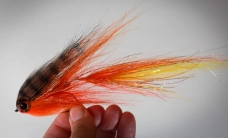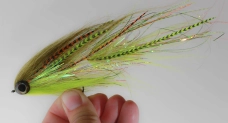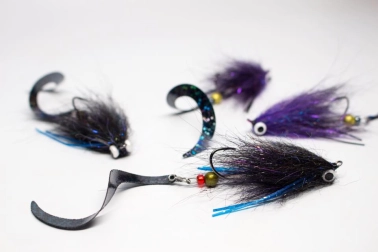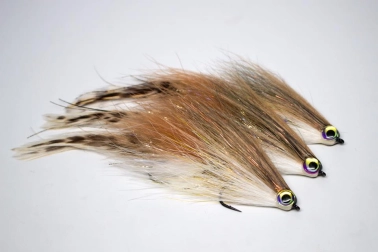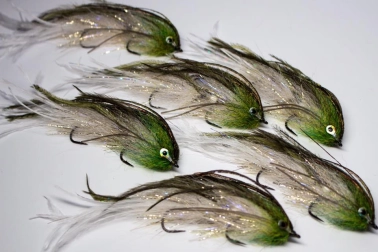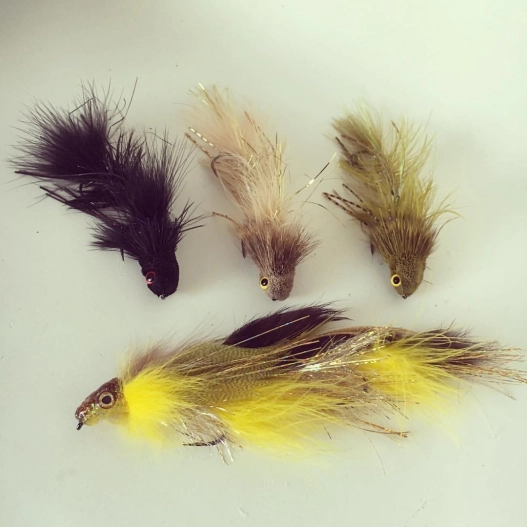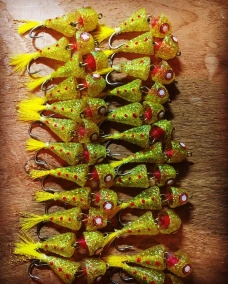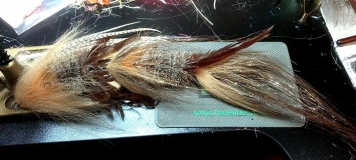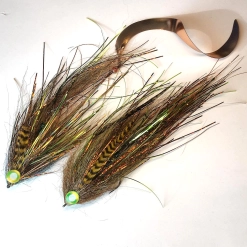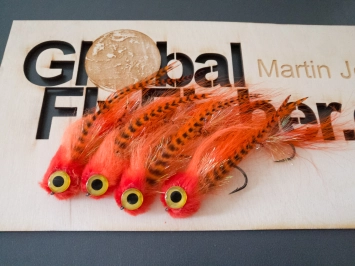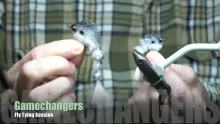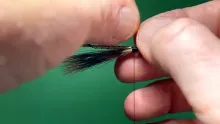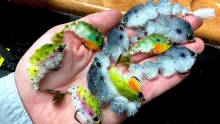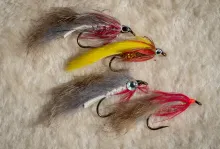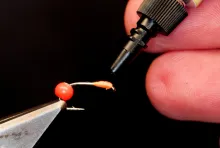One of the big things in fly tying these days is articulated flies. Utilizing two hooks, shanks or some other technique, flies get two or more parts linked together resulting in movement and size.
Articulated has two meanings: “put into words” or “having two or more joints connected by a flexible link”. There isn't much guessing which one is used when it comes to flies... Articulated flies are flies with one or more sections connected in some way that allow the sections to move independently.
This type of fly used to be rather exotic, and was rarely seen until a few years ago. Nowadays we see a ton of flies tied in sections, and not only large pike or saltwater flies, but also trout flies and even nymphs. Even though many of the trout flies are smaller than the large pike streamers, they are still often large flies by trout streamer or nymph standards.
Other naturals
The most common naturals to imitate is of course fish, where the potential size, elongated shape and the movement of the articulated fly lends itself well to mimicking fish shapes.
But other naturals are imitated too from larger crayfish over shrimps to caddis and mayfly larvae. Larger nymphs such as hexagenia nymphs have been tied with articulated extended bodies, by tiers like Michigan angler, guide and author Matt Supinski who even ties smaller nymphs such as caddis with an articulated abdomen. Such nymphs are often referred to as Wiggle Nymphs.
Danish Kern Lund, well known in northern Europe for his amazing shrimp flies has also experimented with an articulated shrimp fly.
Looking around the web for articulated crayfish will also reveal a few patterns, and the innovative Malaysian tyer Dron Lee has originated a handful of articulated shrimps and crayfish for saltwater fishing. Dron Lee doesn't use shanks, but hollow, extended bodies connected to the front of the fly – the rear section of the animal – with flexible materials or a line.
Movement and size
There are two main reasons for wanting to make a fly in several sections: movement and size.
Movement of course comes from the fact that the fly gets one or more flexible links. That will allow the tail section in particular to move independently of the front, and can give some surprisingly mobile flies, that have an impressing and very lifelike swimming action. Flies with more links – two or even three or four, equaling link number+1 sections – get even more action. Seen from above, viewed with an underwater camera or in one of the transparent tanks with current, they can seem almost alive, which is not a bad thing for a fly!
It is also obvious that you can increase the size of the fly by adding an extra section or two. Large flies can be constructed in many ways, and this is one of them.
But articulation isn't a large fly thing only. A lot of tyers tie smaller flies with links, and linked emergers and nymphs are getting more common as articulation is getting better known.
The Tandem Flies
Tandem flies have been known for a very long time from classical patterns such as Secret Weapon and Falkus' Sunk Lure. They are not articulated in the modern sense, but tied with dressed trailing hooks attached with line or wire. Pre-dating these you will even find a number of New England streamers, which were tied in tandem, also with a dressed trailing hook rather than the long streamer hooks, which were – and still are – the most common hook configuration in these long streamers.
The trailing hooks are usually sparsely dressed with just a single color or two, maybe just a body material and a rib and rarely feathers or fur.
The Intruders are a more modern variations on the tandem sea trout, salmon and steelhead fly. Again the trailing hook is often bare, but the step from tandem flies or Intruders to an articulated fly isn't long.
My first articulated flies
Back in 1996 I published an article where I used simple home made shanks to make flies, which quite resemble the current articulated flies in construction. I referred to them as Linked Flies. At that time I had never heard of the concept of articulation, and was just fooling around. The article can of course still be found here. These were simply my usual coastal flies, just tied in two sections with a tail tied on a home made shank linked to the main hook with a mono loop.
I also tied and fished what can be referred to as an articulated fly in 1998 where I made the Banderilla tube fly, which I used for cod fishing. I connected several sections of individually dressed tube sections on the tippet to get a very long and flexible, worm-like fly, which I have come to refer to as “tubiculated” flies. I am working on an article on this concept.
Other sources
Other people have toyed with similar constructions, and I certainly don't want to take any kind of credit for the ideas, which I may have come up with myself, but most likely picked up from some one else or was inspired to do by something I saw other people do. I honestly don't remember.
This article from the beginning of the 2000's by Steve Burke talks about the Articulated Tiddly, a leech pattern, developed “10 years ago”, which places it in the beginning on the 1990's. The article refers to the history of steelhead flies as the ancestors for modern articulated flies, which I consider to the absolutely right place to look for the current articulation heritage.
Beads or pearls
Beads or pearls threaded on the connecting wire between two hooks are quite common as already mentioned. The beads mainly serve the purpose of holding the double wire together, keeping the often smaller rear hook or soft body materials from getting caught in the opening. The beads can serve other purposes too:
- They can add some stiffness to a soft wire, keeping the fly from kinking, but again: most people use strong and stiff wire, and that isn't usually to be the main reason.
- They can keep the rear hook from sliding up the loop. This requires enough beads to almost fill the gap. If the rear hook connection is secured with varnish or wraps, the beads don't make any difference.
- They can add a contrasting color under the materials.
- They can rattle a bit. Some beads will slide on the wire and add noise when they move, but it's nowhere near what real rattlers do.
- They protect the wire. Since people often use very strong wire and materials already cover it, this is rarely an important issue.
- They do add a little volume to the fly, but on big flies... not much.
- Using heavier beads gives the option of adding weight to the fly to help it sink.
Two hooks
The simple way of making an articulated fly is to use two hooks. You can connect them with metal wire, heavy mono or fused line in such a way that the rear hook can move freely.
The front hook is usually larger and has a longer shank. Rear hooks are sometimes selected of a shorter shank type and stinger hooks with up eyes are not rare.
The norm is to tie on the rear hook, add the wire, tie the wire to the front hook and then dress that. Many tyers thread pearls or beads on the connecting wire. See the box on beads for more info.
You can fish a two hook fly with two points or cut off one point - rear or front, depending on the pattern, your preferences or fishing rules. Many anglers report “short strikes” on the long flies, and prefer having a hook in the rear end of the fly, while others have a hook in the front and the articulated link or links acting as a body and tail with no hook.
Traditional trailing hooks or stinger hooks as it's found on Intruders, don't really fall in the category articulated flies because you usually don't tie any material on the rear hook. As the name implies, it simply trails after the fly to give a hook point in the rear.
The game changes
One of the real breakthrough patterns to enter the articulated fly scene was Blane Chocklett's Game Changer, which did really change the game. Chocklett is also a big fly advocate, tying huge flies such as his T-Bone Musky Fly and other patterns, but while many of these are tied in the traditional large fly manner – one large hook and a lot of materials – the Game Changer uses a radically different method: not just one link, but a long series of short connected shanks, each covered with material and trimmed in such a way that it completely hides the underlying backbone or spine structure.
The fly is almost über-articulated, and seeing it in the water is very convincing. The mobility and natural swimming motion is very impressing, and even though the fly is both large and fairly heavy, it's lighter than many large hook streamers.
Articulated shanks
What really gave that style of articulation air under the wings was the appearance of dedicated shanks.
We have known Wadington shanks for ages, but like trailing hooks, a traditional Wadington fly is not really articulated, but just another method of placing the hook in the rear part of a larger fly, and oftentimes the hook is fixed and can't even move much relative to the shank. On the other hand, the Waddington shanks can be used for articulated flies like any other type of shank.
Intruder shanks have been around for a while, but most are quite large and heavy, and what you need for articulation is typically shorter and lighter.
The shanks link together to form a spine, and and after tying the fly on all sections, the spine is still flexible and will allow full movement. The first of these shanks were home made, simple as they are, and I made such primitive shanks back in the late 90's as mentioned above. A hook with the bend cut off will of course also work, as it does on Intruders.
The US manufacturer Flymen Fishing Company was one of the first to produce shanks for spines for articulated flies commercially in a larger number of wire thicknesses, lengths and even colors, and are still the leaders in the market for shanks. But these days a lot of manufacturers have shanks on their programs.
Offset or straight
You can now get shanks in several constructions: single or double eye, straight and twisted/offset.
A single shank with an eye is like a cut off hook and will require a wire connection.
The ones with eyes in both ends can have eyes in the same angle or twisted/offset with eyes perpendicular to each other. The advantage of the latter is that they can be coupled directly and all have the same orientation, while the first kind call for every second link in the spine being turned ninety degrees in relation to the others – or the shanks have to be linked indirectly using wire or line as the flexible link.
If the shanks are single wire it makes little difference, but if the wire is double, it's usually easier to tie with the “flat” side of all shanks the same way. So unless you tie “in the round” with no orientation, it's preferable to have the shanks identically oriented and to tie on them flat with the wires side-by-side rather than on top of each other. This also makes it easier to mount the shanks in the vise while tying.
Shank configuration
There are quite a few dedicated shanks on the market now. They are typically fairly lightweight, come in several lengths and have offset eyes, perpendicular to each other, which enables you to connect them directly.
Again the choice is between a rear or a front hook or both, even though a center hook is also possible, but very rarely seen. A front hook is the most common configuration, leaving the articulated tail more freedom to move, but some tyers like really small, rear-mounted hooks – or both a front and a rear hook.
The usual way of tying articulated flies on shanks is from the rear, starting with the tail section tied on the rear shank or hook. You then connect that to the next shank in line, tie on that and so forth, until you reach the hook or front shank. A hook is connected using a wire and you then tie on the front hook or shank towards the front where you tie the head and finish the fly as usual.
Since the fly is growing as you tie, and the rear eye on the current shank is used for linking to the previous section, gripping the shank in the vise can be a little challenging.
Wiggle tails
A special type of articulated fly is a large streamer with a wiggle tail mounted. It's not a clean cut articulated fly, but bears some of the traits, namely being a very mobile fly where the parts are linked.
The fly is tied as always, but before dressing the hook, you tie on a wire loop in the rear. This loop is left empty, and at waterside you mount the desired wiggle tail adding significant length and mobility to the fly.
Swedish Niklaus Bauer has refined this rig, which now in many cases bears his name and is used in many places and by many tyers. It can even be bought ready made as the Bauer Pike Rig from several manufacturers.
“Truly articulated flies” tied on shanks or two hooks can easily be equipped with a wiggle tail since the rear shank will usually have an eye where it can be attached.
Modular flies
The detachable wiggle tails brings me on to the last installment of the articulation principle, namely the modular fly, which is made by connecting several parts at waterside to get the fly you need.
Modules can be heads (Heavy, eyes, foam, popper), body (skinny, full), tail (wiggle tail, bushy, mobile), hook (dressed, bare).
These are connected using different locks and wire.
Modular fly sections can also be tied on tubes, making the connection very easy: you simply thread the parts you want onto a leader and add a hook. We have covered modular or convertible flies here.
A few names
Looking at the "large streamer community" based around some of the larger US brown trout rivers, you will see that swinging large streamers for large trout has become popular.
I love the big flies. They are fun to look at, fun to tie and definitely fun to fish too.
Here are a few names that I follow or have bumped into when I look for large flies and articulated flies online, which I do on a regular basis.
A name such as Kelly Galloup is obvious to mention in that connection, Galloup having an important part in popularizing the large streamers for trout and also having started sort of "connecting several streamers" in the early 2000's. Since then Galloup has originated several well known articulated streamers such as the Sex Dungeon, Butt Monkey, Boogie Man and many more, and helped propel the fame of others such as Russ Madden's Articulated Circus Peanut..
Greg Senyo is a name that will often be connected with adapting the steelhead flies to an articulated tying style, and many of these flies carry his name such as the Senyo's Wiggle Prince, Senyo's Iced Out Sculpin, Senyo's Egg Stealing Wiggle Sculpin and more. Some of these are trailing hook flies, some are genuinely articulated. Senyo has even given name to a series of shank products, mainly for tying salmon and steelhead flies with trailing hooks.
Blane Chocklett has already been mentioned. Blane's prime influence is the Game Changer, but the mere number of variations of this fly makes it more than one pattern. Chocklett also originate the T-Bone, another large streamer, not articulated, though. Blane is also on Facebook.
Brad Bohen is also one of the "grand old men" in articulated flies. As he says himself "early practitioner of the large, articulated style of predator fly design"
He tells:
A lot of stuff has evolved since then. I really didn't get overly into the design until 2007 when I tied a couple of flies for a client called Atomic Rats that he went onto a catching spree with.
In 2009 Robert Thompson shot Zero2Hero and filmed myself and Brian Porter tying articulated - 2 hook flies and I even commented on film about the 3 hook triples we were playing with.
We stuck to this concept for several seasons...but many flaws started to become apparent!
The wire articulations failed randomly. Fish got needlessly injured and we all began to suffer from overuse issues from casting the heavy, bulky flies over and over.
Being pragmatic by nature I began seeking a better mousetrap and discovered that I could articulate with a trick the salmon/steelhead guys had been using for years...the waddington style shank used for intruders.
This was prior to the current designs made popular by Flyman and Blane Chocklett... in fact I'll say that I was showing Blane my concepts at his place before he went to Flyman... I've got a picture of a large musky I caught on one of my single hook articulated concept flies. I caught that fish out of his boat on his water - we were truly collaborating - that really made the idea 'real' to both of us and several months later the Blane shanks were introduced and the 'fish spine' concept was launched.
In the meantime I began revisiting my own wire twisting (I spent years making my own inline spinner baits and dusted off my old Boggs Tacklemaster) and came up with the design for my Bohen 747 concept fly. The available waddingtons were too flimsy to make truly viable predator flies!
I've since refined and continued with the single hook articulation and feel it's a superior method and solves all of my initial 'flaws' almost totally.
Brad is working on cranking up a fly tying business called Primo Tail, and can probably cater to most needs in the pike and musky realm.
Large fly tyer Michael Schmidt also deserves credit for popularizing the large streamer and introducing the articulated concept into this realm. His Meal Ticket, Voodoo Squatch and Stinky Mayo patterns are popular large articulated patterns, and he keeps on producing large numbers of articulated flies as a commercial fly tyer.
Tommy Lynch's D&D series (Drunk and Disorderly, a part of his Bar Flies Series) is also quoted as articulated fly inspiration by many.
Ray Schmidt, the former head of Schmidt Outfitters in Michigan, has also ventured into the articulated flies with his Articulated Rattlesnake Streamer. The Rattlesnake started out having a trailing hook, but developed into a truly articulated fly.
Paul Monaghan from England ties a lot of beautiful large flies - many articulated - and shares them on Facebook, Instagram and YouTube.
US commercial tyer Richard Strolis ties a lot of articulated flies and has originated the popular Headbanger Sculpin, and has made a long row of tying videos, many showing articulated flies.
US Based tyer Gunnar Brammer is a big fly guy, and his site Brammer's Custom Flies feature many large flies, among them a good deal articulated. Gunnar ties commercially, and you can order his large flies on the site. He also produces tying videos, and many cover articulated flies.
Another production tyer is Samuel Looper AKA Looper Flies, who produces some really interesting flies, among them "traditional" articulated patterns as well as some, which are more like lures, but still castable on a fly rod. Sam is on Facebook as well as on Instagram.
In the UK you will find a tyer such as Glasgow based Dougie Loughridge. He also excels in large flies, and have shown some impressing specimens like the modular Taimen fly seen here. Dougie can be found on Facebook.
Swedish Oskar Hagelin ties a mean large fly too, and his posts on Facebook are worth following if you want to see some neat articulated flies. His blog contains both videos and step-by-step instructions for several articulated patterns and he posts a lot of pictures on Instagram too.
Another Swede, Andreas Andersson, is also a stable supplier of large fly photos in several Facebook groups, a common tyer at shows and another tyer I enjoy following when it comes to inspiration for large streamers and articulated flies. His most famous pattern is probably Sid, named after the odd sidekick in the animated movie Ice Age, but Andreas also originated the Delivery Man, Aino and several other popular patterns.
Niklaus Bauer, Swede too, appears on the Swedish online shop and video channel Kanalgratis.se, and often fishes and ties big and articulated flies.
Last Swede in the bunch is Ulf Hagström, whose pursuit of pike has led him to tie some huge flies of which many are articulated. He also uses wiggle tails extensively to make flies larger and more mobile. Not always articulated, but sometimes both articulated and with wiggle tails. Ulf is also on Facebook and runs the YouTube channel 700 Teeth about pike fly tying and fishing.
Sweden seems to be adapting the large streamers with great enthusiasm, and more Swedes represent the trend. Marcus Loranga Zetterblad and Cedomir Cheddo Kumanov are two of the other Swedish tyers whom I follow on Facebook, and whose flies are always great to look at and a good inspiration for the tyer who wants to venture into large and articulated flies.
Norbert Renaud is a Frenchman living in Ireland, hunting pike and tying flies to suit. Large, colorful, articulated. Flies with an Attitude, which is also Norbert's nom de plus on Facebook.
Nortbert runs a blog called La pension l'ile verte, Boarding on the green island, where he covers pike fishing and fly tying.
There's a lot of tyers out there who like to tie articulated flies.
- Log in to post comments


